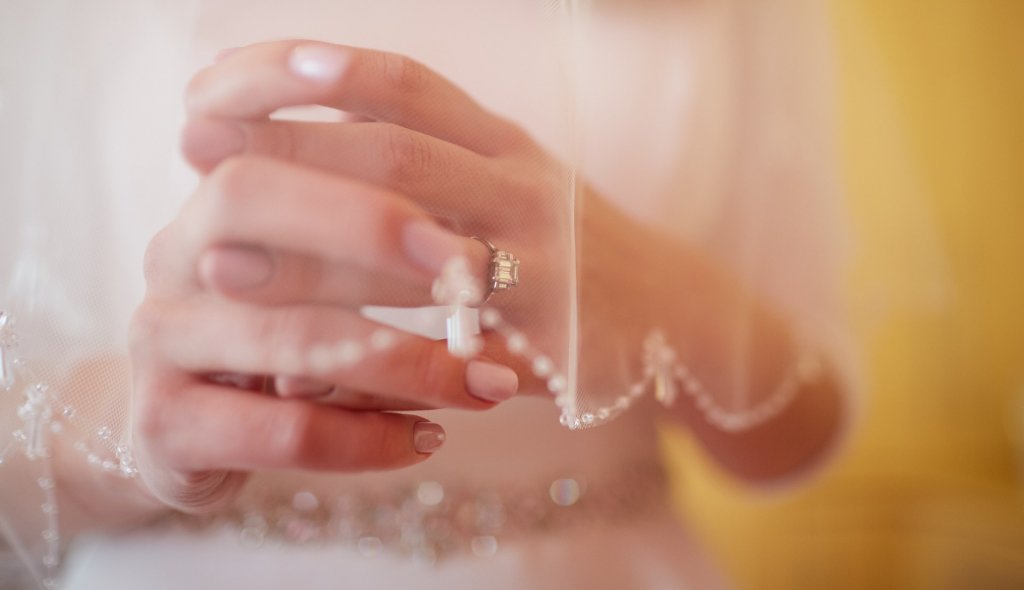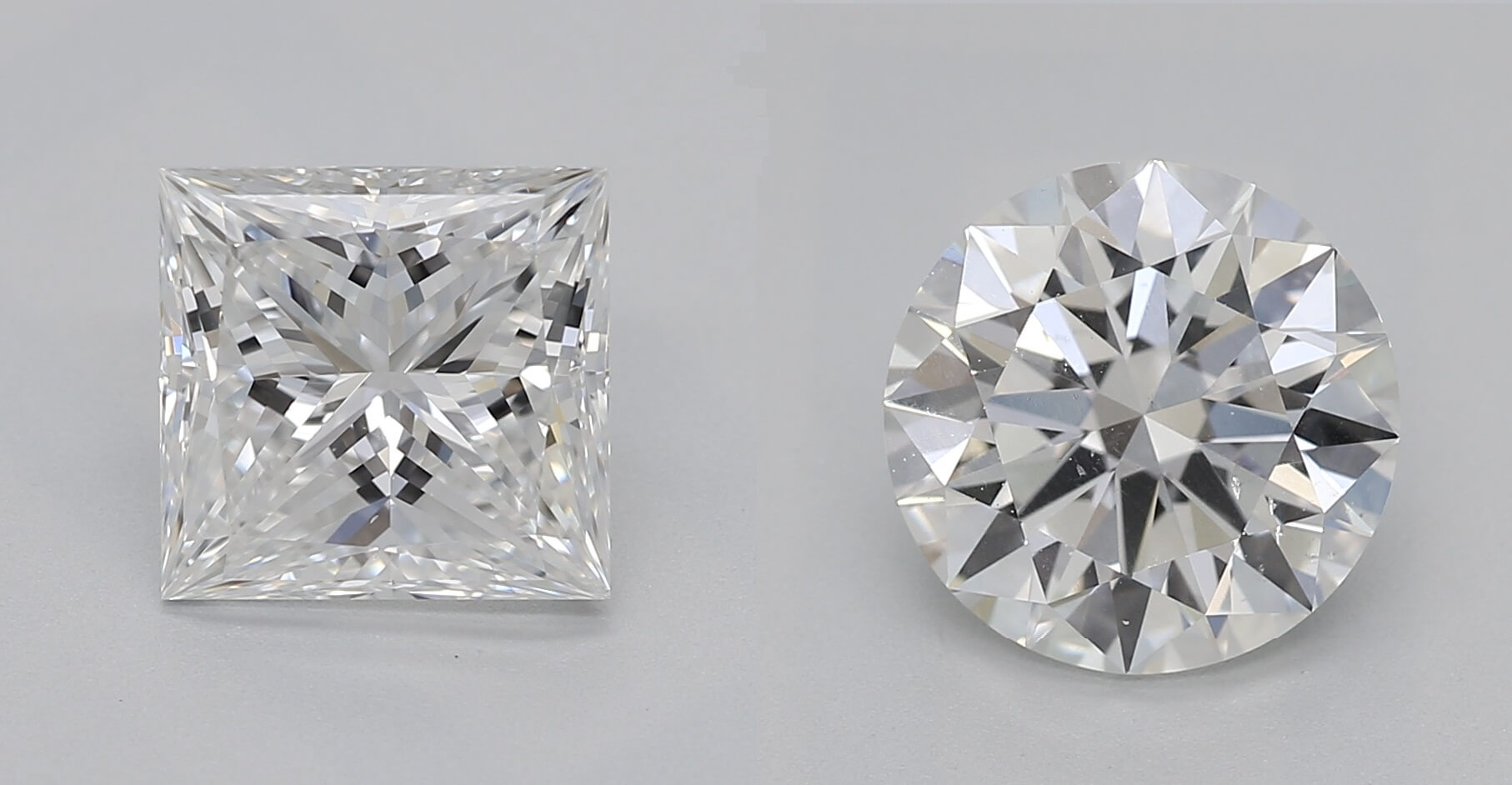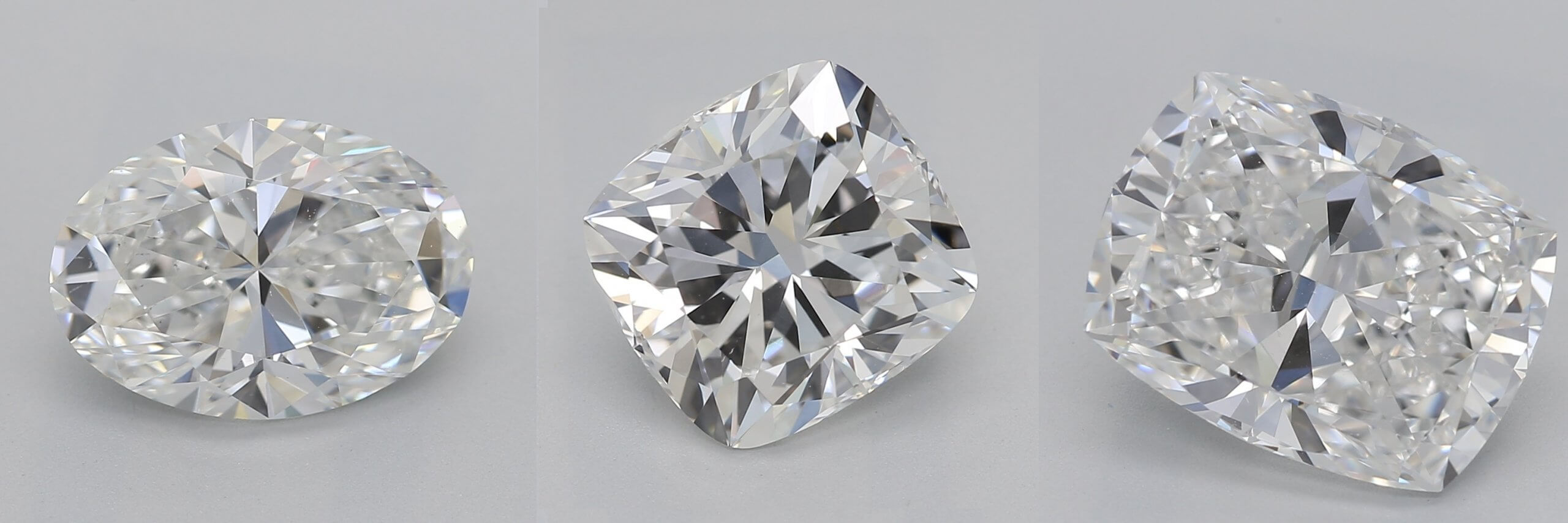The Classic Beauty of a Step Cut Diamond: A Guide
Key Takeaways
- The Step Cut is characterized by larger, rectangular facets cut across the surface of the stone.
- They are an elegant alternative to the Brilliant (Round) or Modified Brilliant cuts, which feature pyramid-shaped facets arranged base to base, and produce a much more scintillating light performance.
- The most Step Cuts are the Emerald cut, the Asscher (or Square Emerald) cut, and the Baguette cut, although the Baguette is rarely used as a center stone.
- What they lack in sparkle, they make up for in a bold, architectural glamour. Reminiscent of the Art Deco period of the 1920s, they make for the perfect vintage-inspired center stone.
- Look out for the stunning ‘hall of mirrors’ effect.

There are many diamond shapes out there. Some, like the Round Brilliant, Oval, and Pear, are true classics of engagement ring design. Others, like the Rose and Mine cuts, are verging on defunct, primarily because their simplicity (a result of their age) means that they are lacking in the sparkle and bright appearance that today’s most popular cuts are able to offer.
Then again, an abundance of sparkle is not everything – and this is a fact that is reaffirmed every single day by the step cuts. In many ways the perfect opposites of the brilliant cuts, with their dazzling facet patterns and firework-displays of fire and brilliance, the step cuts are a lot more understated, though equally as beguiling to a diamond lover.
Slightly less conventional choices for bridal jewelry, but still classics nonetheless, here is what jewelers mean when they refer to ‘step cuts’.
What does step cut mean?
In a step cut, the facets are arranged parallel to one another, and to the edges of the diamond. This stands in direct contrast to the brilliant and modified brilliant cuts, which feature a higher number of smaller facets, often cut into triangular shapes arranged intricately together.
The most popular step cut, particularly for engagement rings, is the Emerald cut. This cut features a rectangular shape with beveled corners, and a glossy, elegant appearance perfect for vintage, 1920s inspired ring designs.
Another popular step cut is the Asscher – although this shape is also known as the square Emerald cut, as a result of the close similarities between the two shapes. Again, you’ll notice the longer, larger facets that comprise the Asscher look very different to the facet patterns found on other popular diamond shapes.
The Baguette cut is also an easily recognizable step cut, although significantly less common as a center stone than either the Emerald or Asscher. Featuring only 14 facets (very few, compared with the Emerald’s 57), the Baguette is a much better accent than it is a center stone. You’ll find it on the shoulders of engagement rings, or channel set within shanks, rather than taking center stage.
This is largely down to light performance – a major talking point when you’re looking at step cut diamonds…
Do step cut diamonds sparkle?
Yes, but not in the same way that brilliant and modified brilliant diamonds sparkle. Step cut facets are longer and larger, meaning that there is a noticeable difference in light performance.
If you held a Round Brilliant diamond in one hand, and an Emerald cut diamond of comparable weight and quality in the other hand, then there’s a good chance your eye would be drawn immediately to the hand holding the Round Brilliant. Even if you prefer the look of the Emerald cut, the Round Brilliant is undeniably the brighter, more sparkly, and more ‘eye capturing’ option.
Step cut diamonds produce fire and brilliance, though without the ‘glitter’ of the brilliant and modified brilliants. Under a light source, you will notice flashes of white and colored light (provided, of course, that the diamond has been cut to a high standard, and good proportions). The effect is highly valued within the jewelry world, and some of the most influential diamonds ever mined were cut with these facets.
The Krupp Diamond is, arguably, the most influential Asscher cut the world has ever seen, although it has also featured on engagement rings worn by Jessica Alba and Pippa Middleton, sister to the Duchess of Cambridge. More popular still, the Emerald has been worn by Princess Grace Kelly of Monaco, Beyoncé, and Angelina Jolie.
What is Art Deco?
Art Deco is an art movement that utilizes geometry, straight lines, and strong, architectural shapes. It is most commonly associated with the 1920s and 30s.
Art Deco is an incredibly popular and versatile style in jewelry. It is one of the best outlets for utilizing elements like the Cathedral setting – grand and elegant, but not too elaborate – bezels or v-prongs, and some truly unique arrangements of accent stones that stray from the traditional halo and pavé designs.
Step Cut Benefits
Step cuts may require you to forfeit the electrifying sparkle of the more popular diamond shapes, but there are plenty of pay-offs to be had.
- They showcase good quality diamonds
Staring into the surface of a Round Brilliant is a little like trying to see through rippling water, but staring into the surface of a step cut is totally different – like staring into a still, glassy lake with a clear view to the bottom.
When it comes to diamonds with impeccable clarity and color, the step cuts are ideal for showing the world quite how exquisite they are, and for demonstrating the innate beauty of the stone. - They bring an understated elegance
While sparkle is high on most shoppers’ lists when they’re looking for a diamond ring, there is a lot to be said for a shape that carries a more modest, understated sort of allure. - They feature versatile shapes
Sure, a Round Brilliant solitaire is the silhouette most of us think of when we hear the phrase ‘engagement ring’, but the beveled squares and rectangles of the step cuts are perfect for creating totally new designs that blend together modern, minimalistic vibes with the classic, Art Deco shapes created by the shapes’ unique facet patterns. From the solitaire to something a lot more unique, step cuts are being explored in modern ring design more than ever. - They create the ‘hall of mirrors’ effect
This is something you’ll likely hear your jeweler referring to if you choose to pursue a step cut. Looking into the diamond’s table, you’ll notice a fascinating optical effect reminiscent of the long, seemingly endless halls of mirrors at the county fair. This is created by the highly ordered pattern of light and dark spots created by the facets on the crown and pavilion, and one of the most convincing arguments in favor of a step cut for your engagement ring. - They are more affordable
Step cut diamonds are among the most affordable diamond shapes out there. This is down to a variety of factors, including their lack of popularity (relative to, say, the Round Brilliant), and the fact that diamond cutters are able to preserve a lot of the rough diamond’s original weight.
In fact, a shape like the Emerald can cost thousands of dollars less than a Round Brilliant, the most expensive diamond shape, of a similar carat weight, clarity, color, and cut quality. - They tend to look bigger
Not only does their comparatively low cost mean that most shoppers can look at slightly higher carat weights than those pursuing the more popular shapes, but step cuts also offer a great ‘face-up’ appearance that makes the most of their weight.
For starters, the longer, regular facets and hall of mirror effect generally have a lengthening effect on the shape. You can see this most clearly in the Emerald cut – a long, sleek appearance that helps it to look larger than other shapes of the same weight.
Beyond that, however, the step cuts tend to feature more weight in the crown and table, rather than the pavilion, meaning that they really do have a larger surface area than some shapes, like the Round Brilliant.
Step Cut Disadvantages
There’s no denying that the step cuts are highly captivating, but they’re not the right choice for every engagement ring…
- Less sparkle (obviously)
The lower popularity of the step cuts primarily comes down to light performance, rather than the appearance of the diamonds themselves. One of diamond’s most unique and valued traits is its ability to create light performances unlike any other gemstone out there, and that incredible combination of fire and brilliance we see in the Oval, Cushion, Princess, and, of course, the Round Brilliant are just too much to pass up for many people. - Clarity and Color are a little trickier to get right
We mentioned earlier on in the article that the step cuts are great for showing off the diamond’s inner beauty but, obviously, that means the diamond you choose really does need to have a strong inner beauty in the first place.
Eye clean diamonds are available at plenty of clarity grades and, even for a cut like the Emerald or Asscher, you won’t need to go for the most expensive options at the VVS and IF clarity grades just to find something worth buying. That said, you probably won’t find anything good at the lower end of the scale, either.
While the modified brilliant shapes are great for concealing slight flaws amid those many, small facets and the continuous flashes of fire and brilliance, the ‘inner workings’ of the step cuts are laid bare.
The same rules apply: find a diamond that has no noticeable color or inclusions. The search may just be a little tougher. - A yellow or rose gold setting will impact the diamond’s appearance
one of the reasons it’s not worth investing in a particularly high color grade –say, the Colorless grades D, E, and F – is because a colorful setting will inevitably reflect through the diamond to some extent, essentially undermining the extra investment you made into one of the top color grades.
This certainly doesn’t have to be a negative. Many, many jewelers and jewelry wearers love the look of a gold band reflecting through its diamond, and the way those yellow or rosy hues influence the distinctive pattern of the step cut.
It is, simply, a question of whether or not you and your partner like it, or prefer to keep the diamond looking bright, clear, and colorless.
Famous Step-Cut Engagement Rings
If you consider yourself a fan of the step cut, but have no idea how it would translate into a ring design, then it’s worth considering some of the most influential step-cut engagement rings the world has ever seen.
Beyoncé’s 18 carat engagement ring may be out of 99% of budgets, but the classic design, which combines the bold Emerald cut with a split shank decorated in pavé. The design is easily translated into something more wearable (and affordable), while retaining that strong silhouette. Jennifer Lopez and Amal Clooney also opted for the Emerald cut.
Asscher engagement rings have been worn by Jessica Alba, Pippa Middleton, Princess Madeleine of Sweden, while Princess Grace of Monaco famously wore a 10.48 Emerald engagement ring, flanked by two Baguette cut diamonds, created by the legendary Maison Cartier.
And, of course, there’s no point overlooking the Krupp Diamond itself – also famously known as the Elizabeth Taylor Diamond, for obvious reasons. This ring cut encapsulates the glamor and opulence of Hollywood’s golden age – and, with it, an incredible aesthetic.
Step Cut Engagement Ring Ideas
From the classic solitaire to the ultra-sparkly three stone engagement ring, the step cuts are versatile to be worked into almost any design. Here are a few of our favorites.
East-West Emerald Engagement Ring
Take advantage of the Emerald cut’s rectangular silhouette, and transform it into a much more modern classic by having your jeweler set it horizontally across the shank, rather than in-line with the finger. It’s surprising how such a small change has such a big impact on the traditional solitaire design, and how aligning the Emerald cut’s facets with the shank creates a strikingly linear effect.
Asscher Bezel Engagement Ring
Another way to highlight the elegant shapes of the step cut’s facets is to set the diamond within a minimalistic and highly structured bezel setting. Doing so effectively creates an ‘outline’ for the stone, and mirrors the shapes that reflect through the table and deep into the center of the diamond.
A bezel setting does mean that your diamond’s ability to draw in (and, consequently, emit) light will be more limited, but you could off-set this by incorporating a pavé setting into the shank – or simply focus on highlighting the diamond’s beauty beyond its sparkle, which is what the step cuts are so effective at doing.
Three Stone Emerald Engagement Ring
Whether you choose to go the Grace Kelly route and combine your Emerald cut with a tapered Baguette on either side, or incorporate a little extra sparkle into your ring by combining the emerald with two smaller Pear, Marquise, or Round Brilliant diamonds, these diamonds offer the perfect central stone for any trilogy ring.
As always, work on finding a reputable local jeweler capable of realizing the full beauty and impact of your design – or, if you’re still stuck on the specifics, of drawing up a design from scratch worthy of whatever vision you’ve got tucked away in your head. Step cuts are a beautiful choice if you want something elegantly understated, and incontrovertibly classic.

Jul 26, 2022 By Willyou.net
Princess cut vs. Round cut Diamonds: The Debate Ends Here

Oct 3, 2021 By Willyou.net
Discover the Most Expensive Diamond Cut: A Guide








